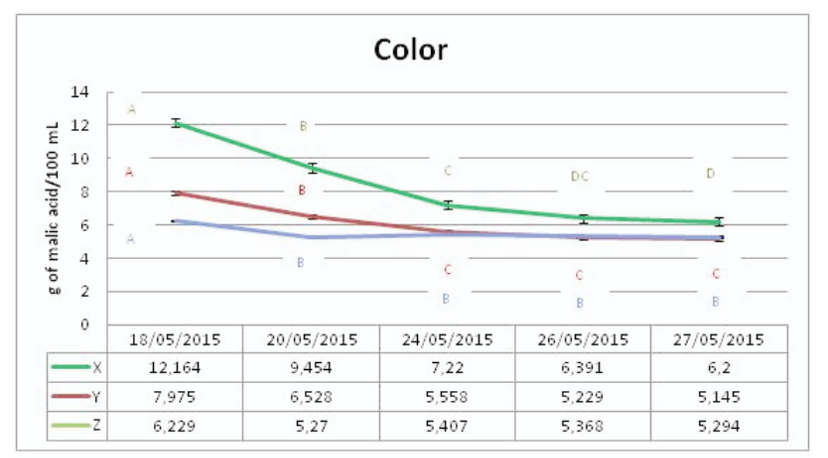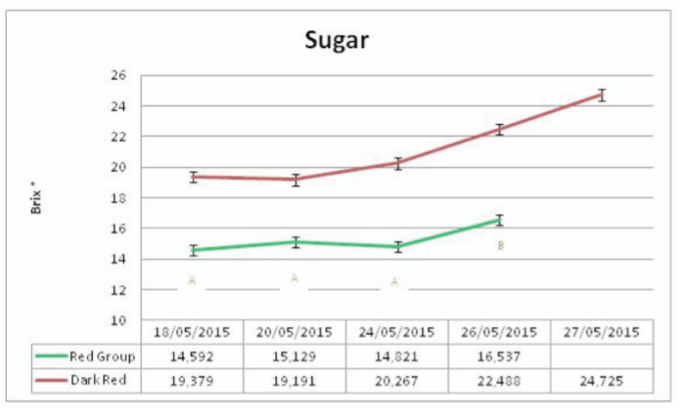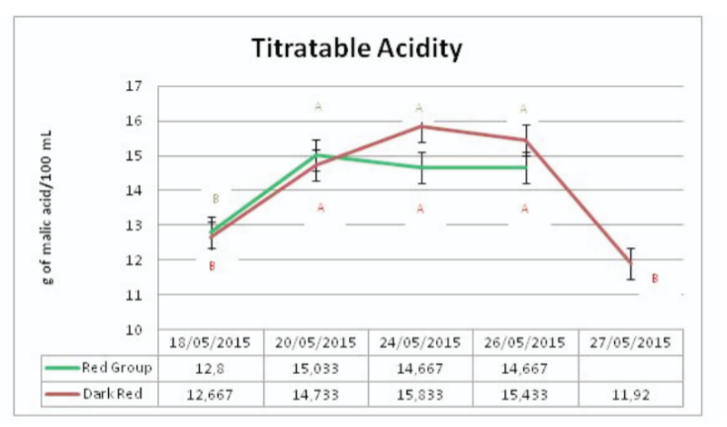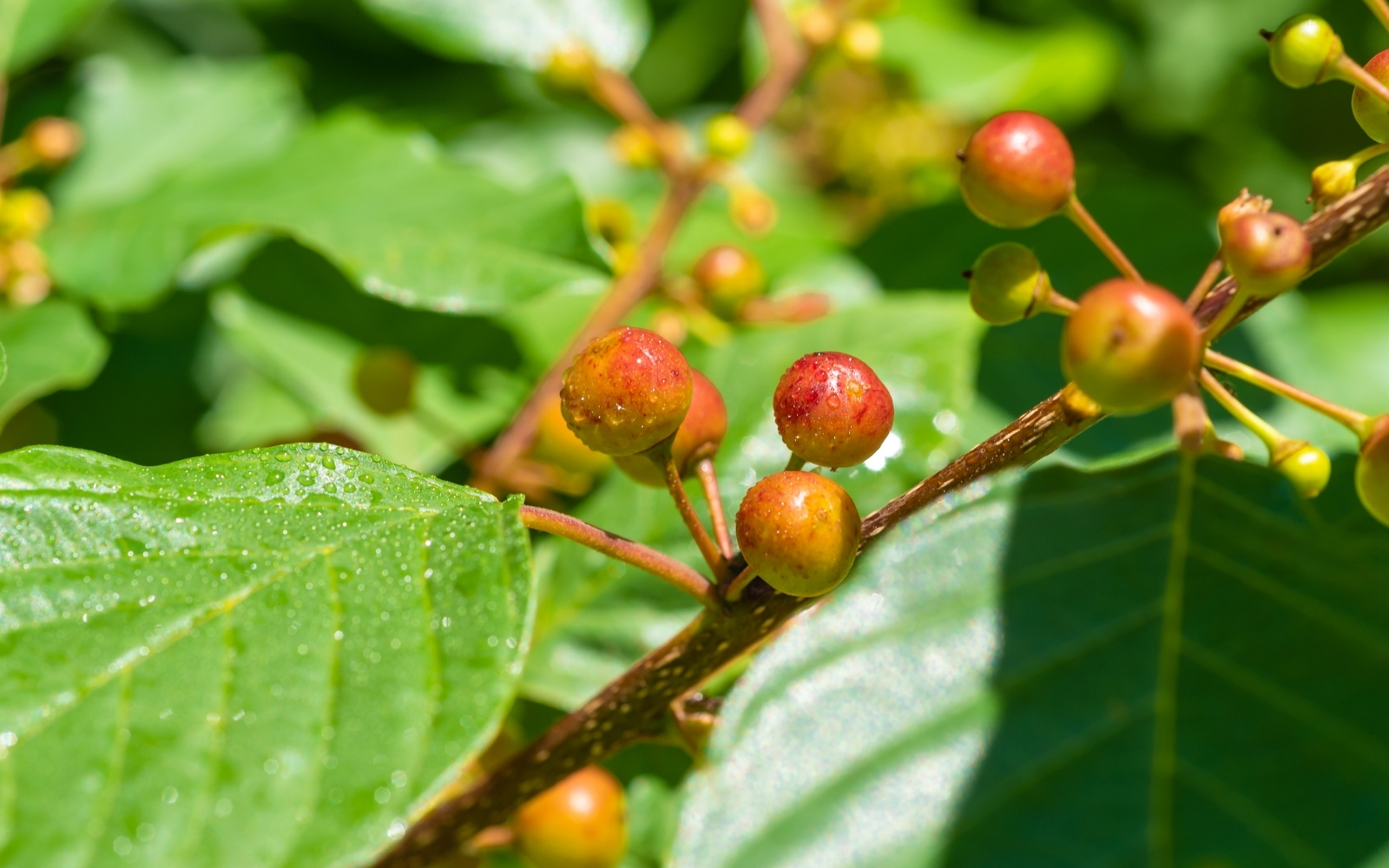August 11, 2025 at 10:11 pm | Updated August 11, 2025 at 10:11 pm | 7 min read
- Sweet cherries’ harvest maturity can be estimated by chronology and physical attributes like skin color, weight, size, and firmness.
- Internal quality parameters like soluble solids content, titratable acidity, and taste can also be used as harvest maturity indices.
- Skin color is considered the best indicator for the optimum harvest maturity of cherries.
- Simultaneous non-destructive estimation of color, soluble solids content, titratable acidity, and taste from near-infrared spectroscopy-based tools gives reliable results in real time.
Sweet cherries are a popular fruit that have a very short harvest window each year. Estimating the optimum harvest maturity can be crucial to boost consumer acceptance, preserve quality longer, and increase profits for growers and other stakeholders. While the values of the indices are cultivar and region-specific, this article outlines the standard quality parameters and methods used to determine the optimum harvest time.
Why Sweet Cherries Need Harvest Maturity Index
Sweet cherries (Prunus avium L.) are non-climacteric fruits. Cherries are highly perishable due to their high respiration rate, resulting in a very short shelf life.
Harvesting at the correct time is therefore crucial to balance the development of fruit size, skin color, and flavor, which must occur on the trees. Harvesting early, before cherries are ripe, yields small fruits that lack satisfactory color and flavor development. According to Washington State University, harvesting just a few days later at the optimum harvest date can produce cherries that are 40% larger, with darker skin, and with a better taste. However, if the harvest date is postponed too much, soft cherries can suffer from decay, shrivel, stem browning, skin cracking, and pitting. The loss in quality will lead to rejection by customers and a loss for the growers and other stakeholders in the supply chain.
Subscribe to the Felix instruments Weekly article series.
By submitting this form, you are consenting to receive marketing emails from: . You can revoke your consent to receive emails at any time by using the SafeUnsubscribe® link, found at the bottom of every email. Emails are serviced by Constant Contact
Cherry maturity at harvest can also affect quality changes during the postharvest. Hence, cherries meant for local markets can be harvested later than those slated for longer transport. The cherry harvest time is relatively short in comparison to apples, and most cultivars fruit within a short period.
Growers can use harvest maturity indices to determine the optimum harvest time. The optimum harvest date allows for the development of fruit quality to meet consumer preferences. It has a long enough shelf life to cover the required time for transport, storage, and retailing. These indices must also be easy and simple enough for use on farms. Indices could cover various cultivars or be customized for individual varieties.
For cherries, crop chronology, physical properties, and chemical composition can be used as harvest maturity indices. Physical and chemical harvest maturity indices use direct measurements of quality parameters in a short run-up of around two weeks to harvest.
Chronology Harvest Maturity Indices
Simple calculation models based on crop chronology, like days after full blooming (DAFB) and meteorological conditions during the growing season, can be used to fix the optimum harvest date. Full bloom is the day when 75-90% of flowers are open. These calculations help estimate general cherry ripening time in normal years with standard growing and weather conditions, to prepare for harvest operations, starting from the day of full bloom. Optimum harvest date equations will, however, need long-term established records of phenological and meteorological data.
Turkey: For the Sweet cherry cv Lapins, 64 DAFB is the accepted harvest index, as it is positively correlated with fruit weight, size, color, and taste in Turkey. Until the DAFB, the size and weight of cherries increased. However, after the optimum harvest date, the cherry growth slowed down.
Denmark: A study in Denmark found the best DAFB for harvest for ten cultivars, and found that calculations are better when air temperature is incorporated into the equations.
Annonay- 44 days
Rivers Early- 56 days
Merton Glory- 64 days
Victor- 71 days
Sam- 74 days
Van- 77 days
Starking HG- 79 days
Napoleon- 79 days
Hedelfinger- 81 days
Stevnsbaer- 94 days
Chronology is a non-destructive method of estimating harvest maturity.
Physical Harvest Maturity Indices
The physical fruit quality traits used as harvest maturity index are skin color, cherry width, length, weight, and firmness.
Skin color
Despite the use of other harvest indices, skin color is the most popular means of fixing harvest time for cherries, since consumers choose darker colored cherries. Color estimation is possible through non-destructive observation methods.
The color change in the cherry can be described as follows:
- a) Immature cherry- yellowish
- b) Almost mature- light red
- c) Mature- red
- d) Ripe- dark red
- e) Overripe.
In Turkey, the optimum harvest date of cultivar ‘Lapins’ is associated with lower L*, b*, and h° values and increasing a* value. The color changes slow down after the optimum harvest date.
In Afghanistan, the color useful as a harvest index for the variety ‘Burlat’ was “X: 6.391, Y: 5.229, Z: 5.368 as measured by a chromometer, see Figure 1.
USA: Cherries were scored manually on a 1 to 7 scale based on the “Center Technique Interprofessionnel des Légumes (CTIFL), Paris” method, where one is very light red and 7 is very dark mahogany. The ideal color for commercial/mid-harvest is 2.7 CTIFL for the cultivar ‘Sweetheart’, as shown in Table 1.

Figure 1: “Effects of different picked dates on the 48 fruit XYZ CIE color of sweet cherry cv. Burlat for both Dark (ripe) and Red (mature) groups in Afghanistan, Valori et al. (2017). (Image credits: https://doi.org/10.13128/ahs-20351).
Weight and size
Cherry weight and size, measured in width and length, are also reliable harvest indices. In the USA, weight and size are used to grade cherries.
USA: The country has national-level and regional standards for cherries. US Grade No. 1 sweet cherries must be free from damage by the environment, microbes, and handling. In addition, the cherries must have a minimum size of three-fourths of an inch. The grade US Commercial must meet all the quality requirements of Grade 1 and have a minimum size of five-eighths of an inch.
Turkey: Cherries of the cultivar ‘Lapins’ can be harvested when they have a weight of 93.73 grams, and a width and length of 26.91 mm and 24.97 mm, respectively.
In Afghanistan, ‘Burlat’ cherries must weigh 6.705±0.126 grams and have a height of
19.167±0.254 mm. After the optimum harvest date, cherries will lose weight.
Weight estimations involve destructive sampling. Size can be measured non-destructively and through sampling after picking or on-plant with rulers, calipers, a sizing ring, and a dendrometer, but the method is tedious and involves human error. Machine/computer vision is faster and more accurate.
Table 1: “Separation of three harvest times of ‘Sweetheart’ sweet cherries based on soluble solids concentration (SSC), degree of color intensity, and firmness in the USA. Mean values of SSC, color, and firmness are presented (n = 10),” Chauvin et al. (2009). (Credits: DOI: 10.21273/HORTTECH.19.4.748)

Firmness
Cherry firmness changes along with skin color development, and the fruit becomes softer. Cherry firmness decreased as the date of harvest was postponed. The change in firmness is usually measured through a penetrometer or texture analyzer, using a 6 mm diameter probe, with results expressed in Newtons (N).
Turkey: For ‘Lapin’ cherries, early picked fruits had a firmness of 15.43 N and late-picked fruits had a firmness of 7.75 N.
Afghanistan: ‘Burlat’ cherries of firmness of 0.653±0.037 N are considered to be ready for harvest.
USA: Variety ‘Sweetheart’ must have a fruit firmness of 281.95 g/mm-1 at harvest, see Table 1.
Chemical Harvest Maturity Indices
Several internal quality attributes of fruits, like sugar content, total titrable acidity (TA), and taste, can be measured in the case of non-climacteric fruits to estimate ripeness.
Sugar content
Sweetness is estimated by measuring soluble solids content (SSC), which correlates with color darkening in cherry and increases with ripeness. SSC is measured as Brix through destructive sampling with a refractometer, or non-destructively through Near-infrared (NIR) spectrometers.
Afghanistan: ‘Burlat’ cherries with a sugar content of 22.488±0.5°Brix can be harvested, see Figure 2 (A).
USA: ‘Sweetheart’ cherries from Washington had an SSC of 19.43% at harvest, see Table 1. In the US, cherries must have an SSC of 15-16% to meet consumer satisfaction.
| A. | B. |
 |
 |
Figure 2: “(A) Effects of different picked dates on 48 fruit sugar content (Brix°) of sweet cherry cv. Burlat for both Dark and Red groups. (B) Effects of different picked dates on 48 fruit sugar content and tritatable acidity (TA) of sweet cherry cv. Burlat fruits for both Dark and Red groups,” Valori et al. (2017). (Image credits: https://doi.org/10.13128/ahs-20351).
Total titrable acidity
The TA reduces as the cherry ripens. On the optimum harvest day, its levels begin to fall, as shown in Figure 2 (B). In Afghanistan, the optimum TA levels for ‘Burlat’ cherries are 15.433±0.450 g/ml.
Taste
The ratio of sugar content to total acidity describes taste and flavor. The ratio increases with ripening because the SSC levels are rising. Taste is considered one of the leading harvest maturity indices for cherry. For ‘Lapin’ cherries in Turkey, the optimum ratio of SSC: TA is 20.
In the US, cherries harvested at commercial or mid-harvest season were the most accepted by consumers, even though color, sweetness, and flavor were not the most developed, extending the shelf life of cherries.
Finding the Optimum Measurement Method
Sugar estimation can be cheaper than the precision equipment needed for color or pH measurements, especially when refractometers are used. NIR spectrometers are more expensive but are non-destructive; moreover, portable tools are available on the market, such as the F-750 Produce Quality Meter from Felix Instruments Applied Food Science, which can estimate internal and external color, SSC, and TA, thereby reducing the need for multiple pieces of equipment. The F-750 is precise, providing analysis results within seconds in actionable figures simultaneously for all measured parameters, thereby saving time and labor costs. The F-750 is an industry standard that can be used in the entire supply chain, too, for grading cherries and for quality control to increase ROI by reducing food loss.
Find out more about the Felix Instruments’ F-750 Produce Quality Meter for your harvesting needs.
Sources
Çalhan, Ö., Onursal, C. E., Güneylı, A., Eren, İ., & Demırtaş, İ. (2014). Determination of the optimum harvest date of sweet cherry cv. Lapins grown in Isparta. Türk Tarım ve Doğa Bilimleri Dergisi, 1(Özel Sayı-2), 1905-1910.
Chauvin, M. A., Whiting, M., & Ross, C. F. (2009). The Influence of Harvest Time on Sensory Properties and Consumer Acceptance of Sweet Cherries. HortTechnology, 19(4), 748-754. https://www.doi.org/10.21273/HORTTECH.19.4.748
Christensen, J. V. (1972). Methods for prediction of harvest maturity in cherries. Tidsskr. Planteavl, 217-223. Retrieved from https://dcapub.au.dk/pub/planteavl_77_217.pdf
USDA. (n.d.). Grades of Sweet Cherries. Retrieved from https://www.ams.usda.gov/grades-standards/sweet-cherries-grades-and-standards
Valori, F., Ahkbari, A., Yaqubi, M., Enayat, N., Azizi, F., & Wali Adel, M. (2017). Introduction of determination of optimum harvest date in Afghanistan. Sweet cherry: a case study. Advances in Horticultural Science, 30(4), 231–237. https://doi.org/10.13128/ahs-20351
Wang, Q., Wang, H., Xie, L., & Zhang, Q. (2012). Outdoor color rating of sweet cherries using computer vision. Computers and Electronics in Agriculture, 87, 113-120. https://doi.org/10.1016/j.compag.2012.05.010
WSU. (n.d.). Sweet Cherry Harvest. Retrieved from https://treefruit.wsu.edu/web-article/sweet-cherry-harvest/
Related Products
Most Popular Articles
- Spectrophotometry in 2023
- The Importance of Food Quality Testing
- NIR Applications in Agriculture – Everything…
- The 5 Most Important Parameters in Produce Quality Control
- Melon Fruit: Quality, Production & Physiology
- Fruit Respiration Impact on Fruit Quality
- Guide to Fresh Fruit Quality Control
- Liquid Spectrophotometry & Food Industry Applications
- Ethylene (C2H4) – Ripening, Crops & Agriculture
- Active Packaging: What it is and why it’s important






